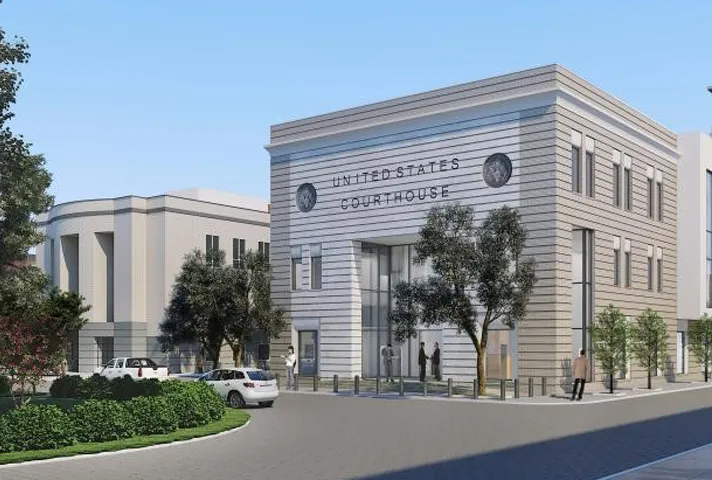Committed to efficiency, safety, and cost containment, the Judiciary has actively reduced the space it occupies in buildings around the country, while also working with the General Services Administration to replace outmoded courthouses with modern, secure facilities.
Cost Savings Through Efficient Space Management
The Judiciary continued to reap cost savings from the space reduction policies adopted by the Judicial Conference since 2013, which are estimated to have produced some $136 million in cumulative savings.
The space reduction initiative is a multi-pronged effort to contain costs by reducing rent payments and making innovative use of technology to foster the efficient use of existing office and courtroom space. The project involves close collaboration among the courts, the Administrative Office of the U.S. Courts (AO), and the General Services Administration (GSA).
The Judiciary in 2019 made progress with its No Net New space policy, which requires an increase in square footage within a circuit to be offset by an equivalent reduction in square footage. The No Net New policy requires ongoing vigilance by the courts to manage space growth. The policy excludes new courthouse construction, renovation, or alteration projects approved by Congress.
The Judiciary established a 3 percent space reduction goal systemwide in 2013. By the end of 2018, it had surpassed that goal, reducing its national footprint by approximately 1.1 million square feet – 30 percent more than its original goal of 870,000 square feet. This produced a cumulative five-year cost avoidance of approximately $105 million. In addition to space reduction and the No Net New policy, the Judicial Conference directed each circuit judicial council to formulate a space and rent management plan for achieving space reduction and to explore opportunities to reduce court space by maximizing technology and flexibility in the workplace.
The No Net New policy is designed to be an ongoing effort that helps courts manage their space more efficiently and avoid costly space expansions. Based on new rules adopted by the Judicial Conference in the fall of 2018, nine No Net New projects were initiated. The projects are expected to reduce the Judiciary’s footprint by an additional 62,000 square feet, for an added $3 million in rent cost avoidance every year.
Judiciary-GSA Initiative
As part of a joint effort, the Judiciary and GSA are working to maximize the value of the approximately $1 billion that the Judiciary pays the GSA each year for rent and related services. As part of the joint Service Validation Initiative (SVI), four training webcasts were held in 2019 on the topics of contracting, building management, and overtime utilities. A national in-person training program on the topics of facilities and security is being planned for 2020.
The SVI agreements have reduced Judiciary costs by approximately $64 million over the past six years by such measures as adopting more equitable annual rent strategies and allowing courts to return unassigned vacant space to the GSA.
The objectives of the SVI, which began in 2015, are to review policies and business practices continually in these areas: appraisal methodology and return-on-investment pricing practice; overtime utility estimating and sharing of energy savings; space assignment, classification, and billing validation; project management; building management, service requests, and building operations; and acquisitions.
The initiative led to the Judiciary and GSA reaching a consensus on a rent strategy that allows the Judiciary to pay its obligations based on fair annual rent (FAR) appraisals rather than on return-on-investment pricing in certain facilities. With the FAR methodology, rent is based on market rates, and appraisals are done every five years by an outside appraiser and reviewed and approved by the GSA. Return-on-investment pricing is used by the GSA when the FAR-based rental rates do not meet its return-on-investment target rate, which is a goal set by the GSA to ensure its assets are recovering the minimum cost of ownership and reinvestment.
Courthouse Construction

A rendering of the new federal courthouse planned for Savannah, Georgia.
Ten new courthouse projects are underway, in various stages of planning, design development, and construction, as a result of construction funds approved by Congress in fiscal years 2016 and 2018. Courthouses in Charlotte, NC; Nashville, TN; and Savannah, GA, are expected to be finished first, in fiscal year 2021. A courthouse in Harrisburg, PA, is scheduled to be completed early in fiscal year 2022. The omnibus spending bills that funded the government in FY 2016 and FY 2018 provided GSA with approximately $1.4 billion for new courthouse construction. Since then, the AO has worked with the GSA and the courts to manage the courthouse building projects.
Emergency Preparedness
To help plan for responses to disasters, the AO during 2019 worked with several courts on their emergency preparedness plans and assisted with emergency support efforts in courts affected by extreme weather.
The AO provided satellite communications sets and training in their use to courts in Alaska and to those located on islands – Hawaii, Puerto Rico, the U.S. Virgin Islands, Guam, and the Northern Mariana Islands. It also coordinated emergency support efforts for courts affected by hurricanes and wildfires. Preparation and response services were provided to court districts affected by wildfires and power outages throughout California and to districts affected by hurricanes in Southern Georgia, Eastern North Carolina, South Carolina, Eastern Virginia, Puerto Rico, and the U.S. Virgin Islands.
The AO facilitated emergency preparedness exercises in several court districts around the country. Each event was designed to increase the Judiciary’s ability to respond to and recover from major incidents by supplying needed resources, ensuring the continuity of operations during disasters, providing training, building relationships with federal and state partners, and identifying areas for improvement.
Annual Report 2019
- Annual Report 2019
- Funding/Budget
- The Courts and Congress
- The Federal Bench
- Accountability and Resource Management
- Facilities and Security
- Public Outreach
- Court Operations and Case Management
- Defender Services
- Probation and Pretrial Services
- Human Resources
- Information Systems and Cybersecurity
- Recent and Proposed Amendments to Federal Rules
- In Profile
